RPA in Finance and Accounting Use Cases in 2025
Updated 05 Jan 2023
17 Min
3276 Views
Financial processes are always stressful, and have zero tolerance for mistakes. Constant document flow and pressure require financial officers to be knowledgeable and mentally strong. So it may be a challenge to find employees that match your expectations. However, technologies can offer an alternative — Robotic Process Automation, also known as RPA.
According to Gartner’s insights, a finance automation solution can work 20 hours a day and cost one-fifth of the amount of an in-house employee. Moreover, you don’t have to spend your time on reviewing and hiring people. Keep up with this post to know more about robotic process automation in finance, its benefits, and use cases.
Market Perspectives
If you want to enter this market with your own solution, you have chosen the best time since its prospects are very bright. According to recent analyst data, the global RPA market size is set to reach $1.89 billion by the end of 2021. Such high numbers mean that many companies are investing in developing this technology, and more and more solutions from this area are entering the market.
In addition to development contributing, companies are investing in integrating this technology into their workflows. If we describe our assertion in terms of numbers, then the total annual RPA spendings are intended to reach $4,308 million by 2022.
On the one hand, it may seem that everyone is just obsessed with the automation of processes, and it is difficult to find a logical explanation for such high popularity. However, everything lies on the surface. Automation of work processes significantly increases the income of enterprises, which is the main reason for its popularity. You can see more detailed statistics of RPA income for different regions in the picture below.
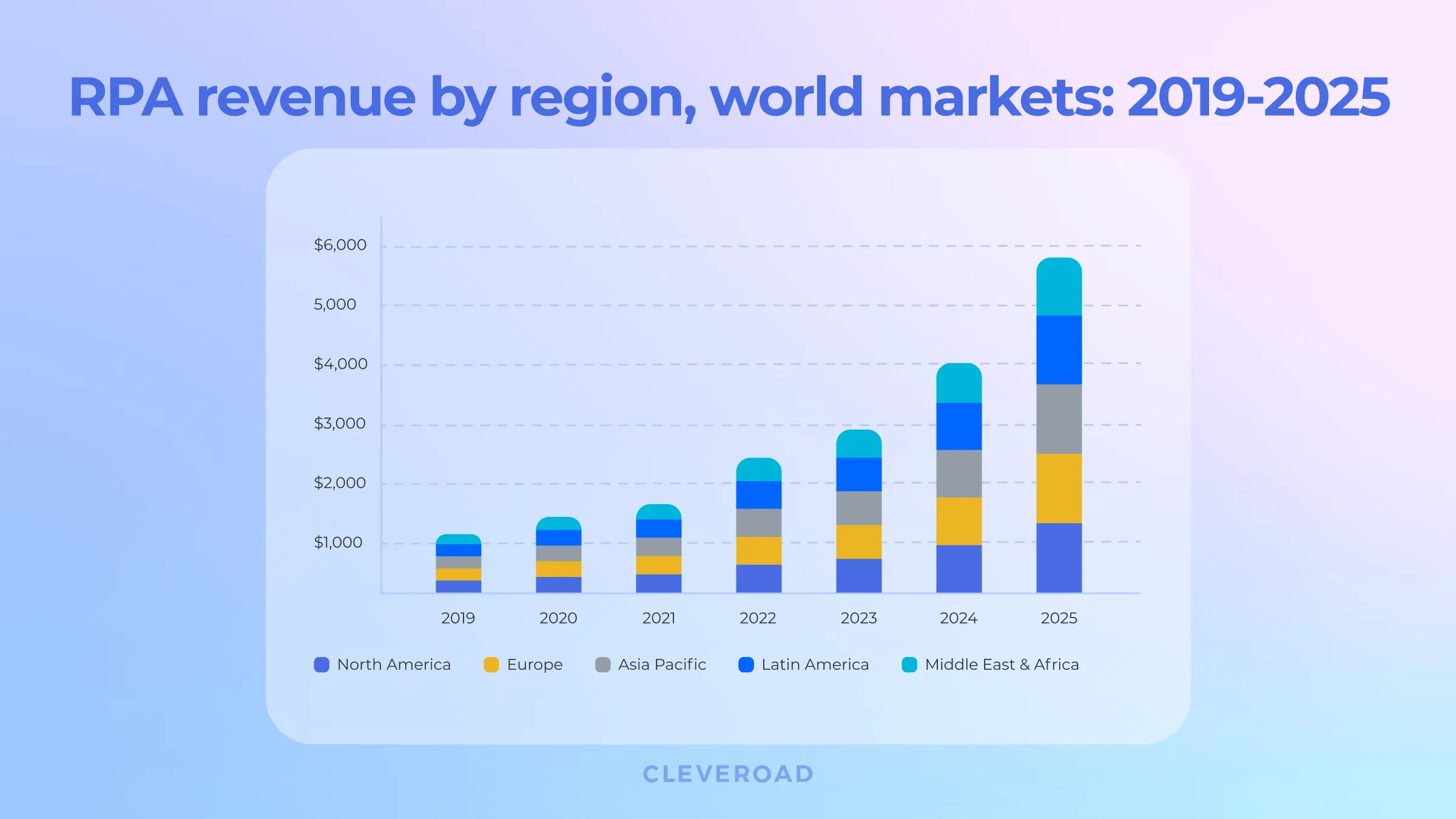
The overall growth of RPA revenue in various regions
What Is RPA in Finance?
Robotic process automation in finance is software that automates routine tasks and reduces the employees' workload. Usually, it’s applied to already existing, well-established financial processes. Automation includes data processing and communication between systems.
Here are some reasons why robots are better at performing routine tasks:
- Robots can’t forget anything.
- Unlike people, robots can work 24/7.
- Robots manage low-level tasks, like typing or transcribing texts way faster than people.
- Robots can’t be distracted. Staff members are frequently distracted by phone calls, chats, and other tasks. But RPA in finance and accounting sector is all about single-tasking, so robots can’t do anything else while they have an unfinished task.
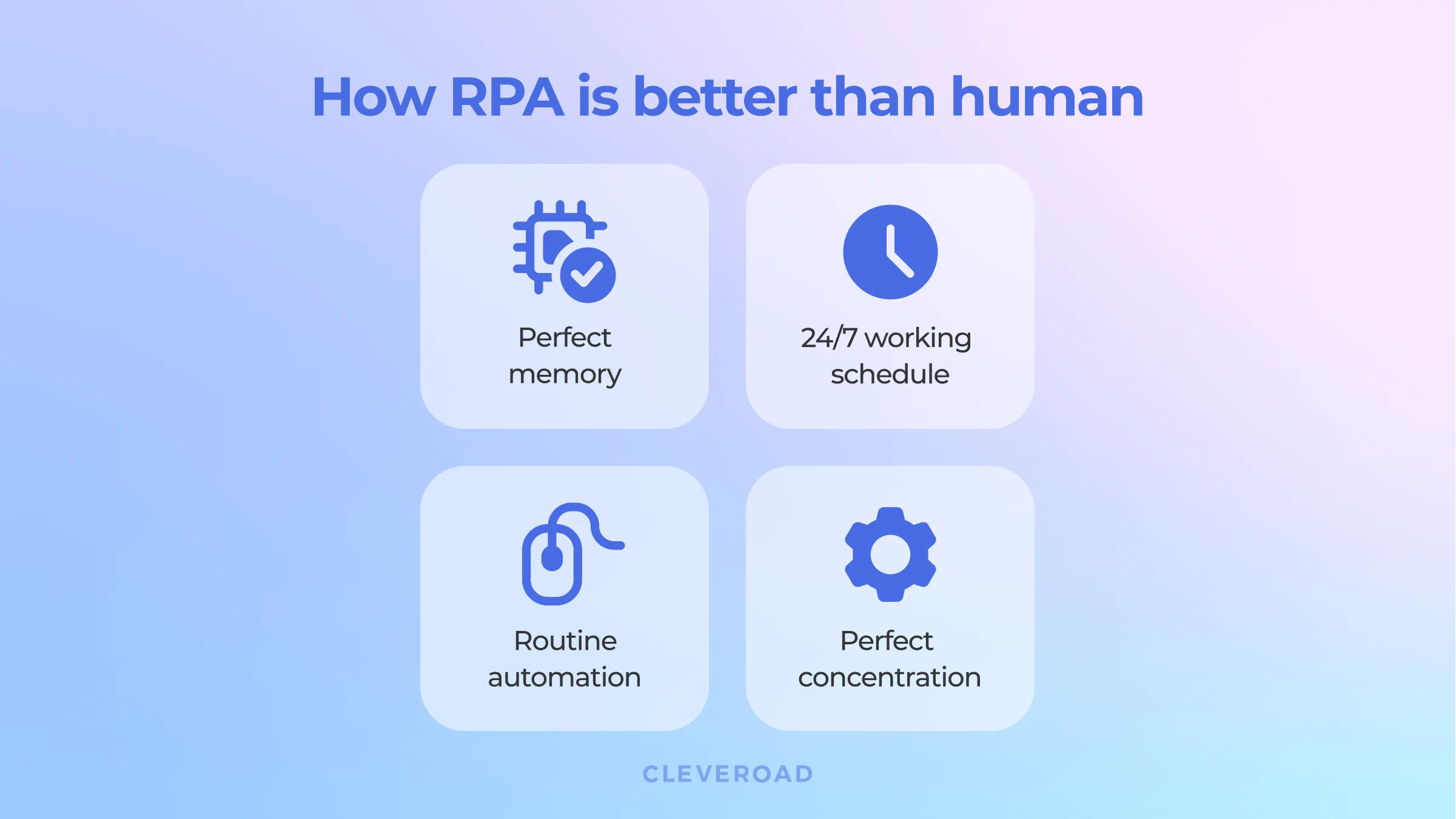
Advantage of RPA solutions over ordinary employees
The list goes on, but the examples are more powerful than facts. Let’s talk about them in more detail.
UiPath and Automated Trade Matching
UiPath is a large New York-based company famous for its automation solution called the UiPath Enterprise RPA Platform. This solution is specifically designed for a financial institution and is designed to improve internal processes such as credit scoring, fraud detection, and many other processes.
According to UiPath itself, they helped an unnamed global investment bank automate deal reconciliation and settlement. This institution experienced acute problems with a high level of errors in operations and, as a result, a high level of financial and time spent on operations with the involvement of in-house analysts. UiPath has helped automate the trade process by placing a robot on hand to process all incoming trades. This approach helped to reduce the processing time of transactions from 40 minutes to 3 minutes per trade.
Blue Prism and Internal Process Automation
Blue Prism is a renowned software development company based in London. One of its main products is the RPA system of the same name, which allows financial institutions to use the power of artificial intelligence to implement efficient robots into workflows.
The company recently helped the Cooperative Banking Group with its RPA solution to automate ten internal business processes. The main goal of this group was to reduce the number of analysts and accelerate service delivery by automating processes and reducing costs. The list of processes that have undergone automation includes:
- Cancellation of direct debit
- Closing accounts
- CHAPS payments
- Foreign payments
- Audit reports
- Internet applications
- Extraction of cards and pin codes and three more internal processes that are under the NDA
Benefits of RPA in Finance and Accounting
Now that we’re clear with the idea of RPA in finance and accounting, it’s time to review the benefits of this concept. Let’s single out each of them.
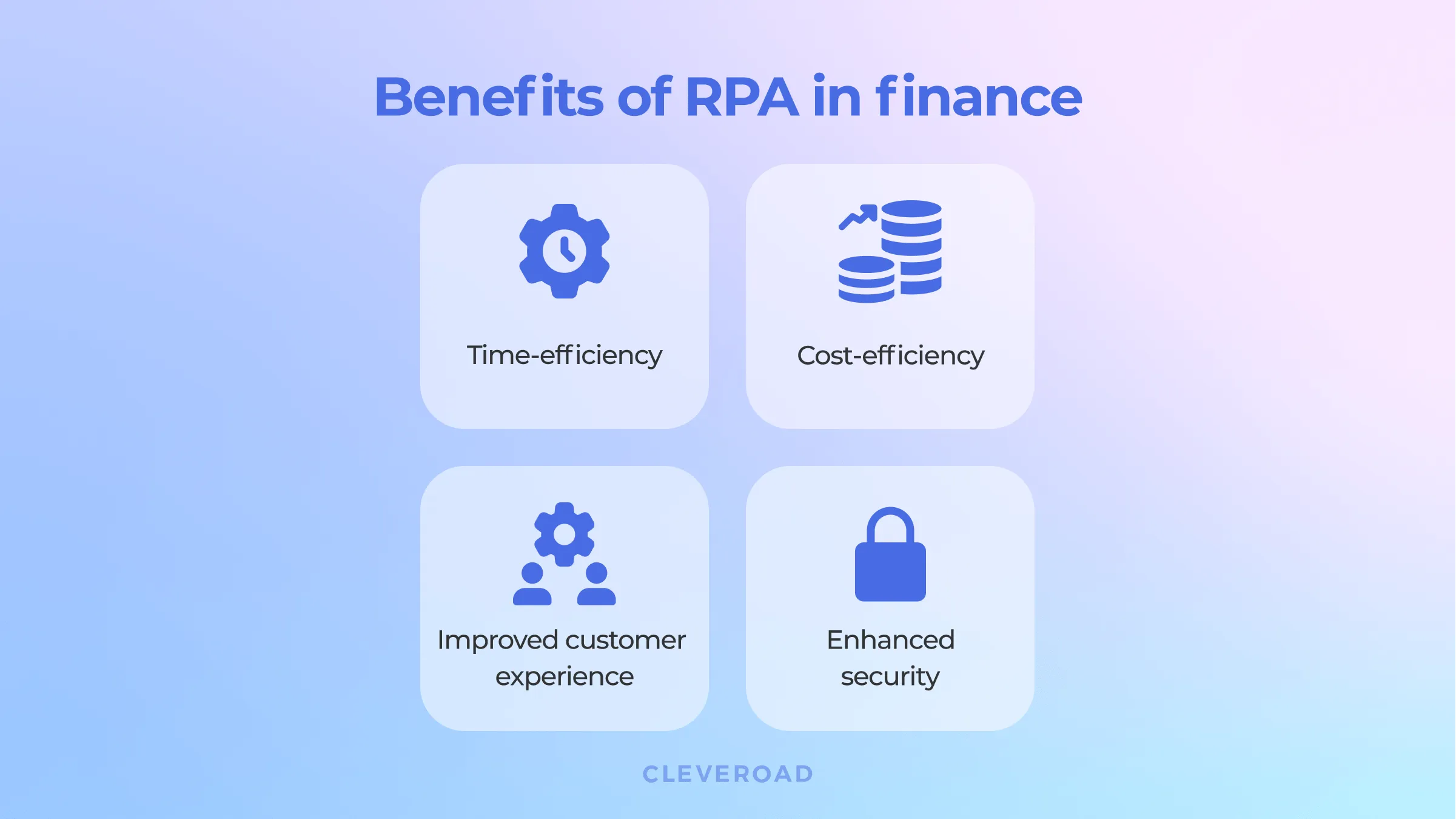
4 main advantages of RPA in finance sector
Time-Efficient Processes
The transition from manual to automated processes increases the performance. Robots can perform the same actions as humans much faster. The execution speed no longer depends on the mood and condition of your employee. Now it’s all about the code optimization and hardware capabilities.
Robots are very effective when it comes to processing of unstructured data. Invoices, for example, require employees to spend a lot of time gathering data from different sources. A human factor can also lead to mistakes during the manual data entry. But well-developed algorithms extract data in a blink of an eye and provide precise data input.
Cost-Effectiveness
It’s obvious that the main goal of RPA in the finance industry is to reduce time and money expenses. Robots can reduce the workload on your employees or even completely replace them. Thus, you cut two expenses at once. If you have an open position, you don’t have to spend time hiring a new specialist. Instead, you can replace your employee with a robot and reassign the officer to a vacant position. In the end, you will get an automated process and an experienced employee in a new position.
Another benefit of RPA in finance is a rapid ROI. It’s hard to say the exact pay off term because the RPA price varies according to users’ needs. Still, the amount of money you pay to your employees for performing routine tasks outweighs the cost of development. Let’s imagine that an employee with all the data at disposal will spend an hour making an invoice. A robot can perform this task in a few minutes.
Improved Customer Experience
The integration of the RPA finance system brings benefits to customers. RPA can speed up user data processing, provide information about interest rates for investors, and assist in opening bank accounts. For example, customer onboarding is a long process that requires a lot of manual data entry. In smaller bank branches, customers have to stand in lines because of the small number of bank managers. RPA finance solutions can automate registration, reduce the number of clients in physical branches, and save time for your clients.
Enhanced Security
Know your client (KYC) is one of the most important guidelines in financial services. These regulations prevent money-laundering and detect suspicious transactions.To comply with these guidelines, financial entities have to fulfill three main points:
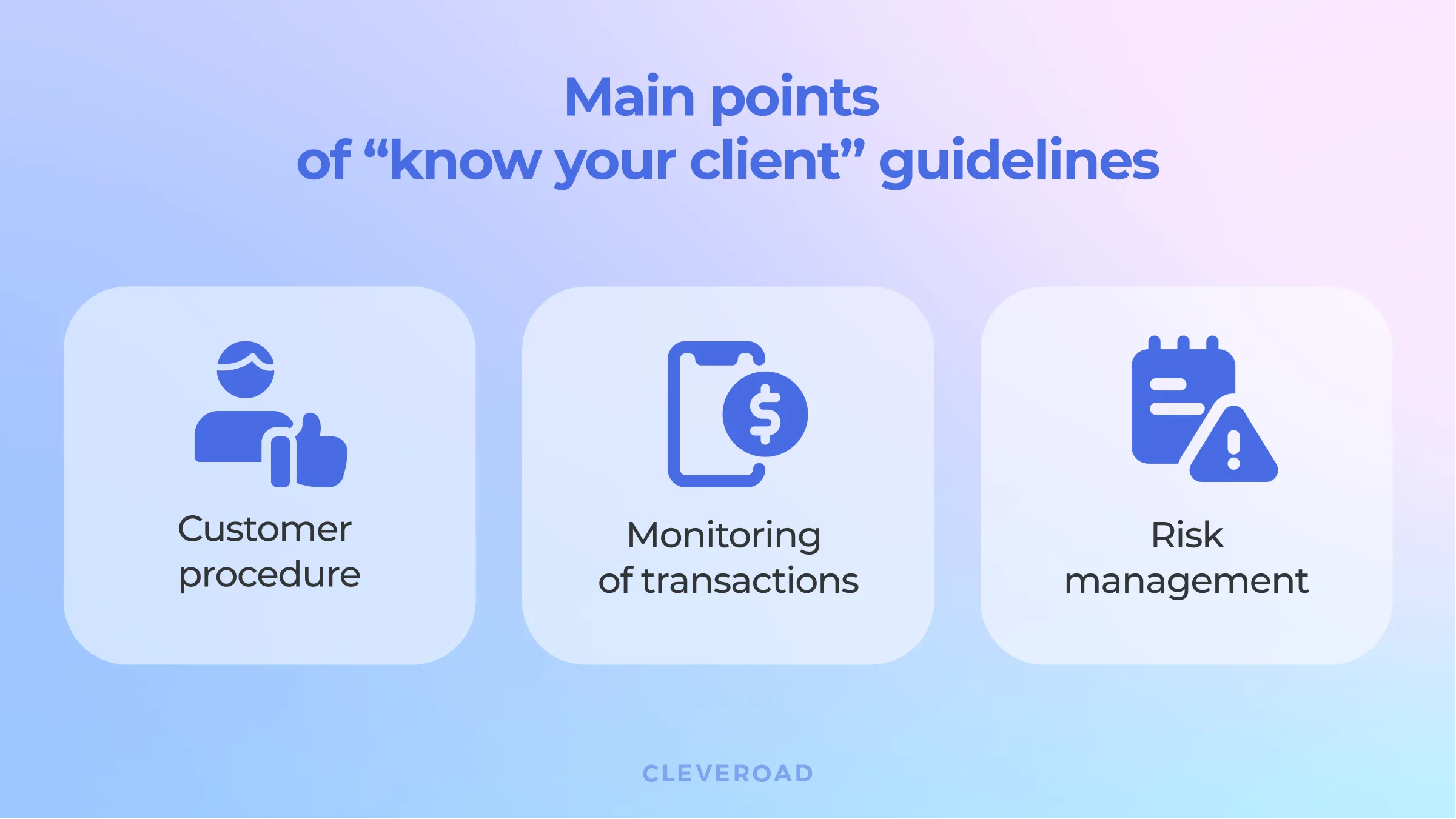
Top 3 pitfalls of "know your client"
RPA solutions allow businesses to collect customer information by accessing databases, gathering data from documents, and social media. Besides, it can help to speed up the risk assessment process. Analysts spend a lot of time searching for information on complex government resources, the FBI, Interpol, and more. Robotic Process Automation in finance industry can deal with these tasks and give analytics more time for other tasks. Robots guarantee the maintenance of the audit trail, which is a major requirement in KYC.
RPA Use Cases in Finance
It’s hard to ignore the benefits of RPA in finance and accounting, but benefits are worth nothing without the implementation. In this section, we’re going to talk about robotic process automation finance use cases.
Accounting
Accounting is a major field that can benefit from RPA in the finance industry. Robotic solutions can automate the process of transcribing invoices from PDF into SAP-compatible formats, and CSV spreadsheets. Besides, RPA software places the finale file version on the server automatically. That’s how it ensures the compliance with the SOX act.
Drafting monthly payrolls is a routine task that isn’t tolerant of any mistakes. However, payroll processes are usually rule-based, require to put large amounts of data, and are highly repetitive. These factors make it a great RPA finance use case. Automation solutions can check the correctness of employees’ payrolls by comparing the data with ERP software. Besides, RPA software can perform gross-to-net processing and supply procurement systems with relevant data.
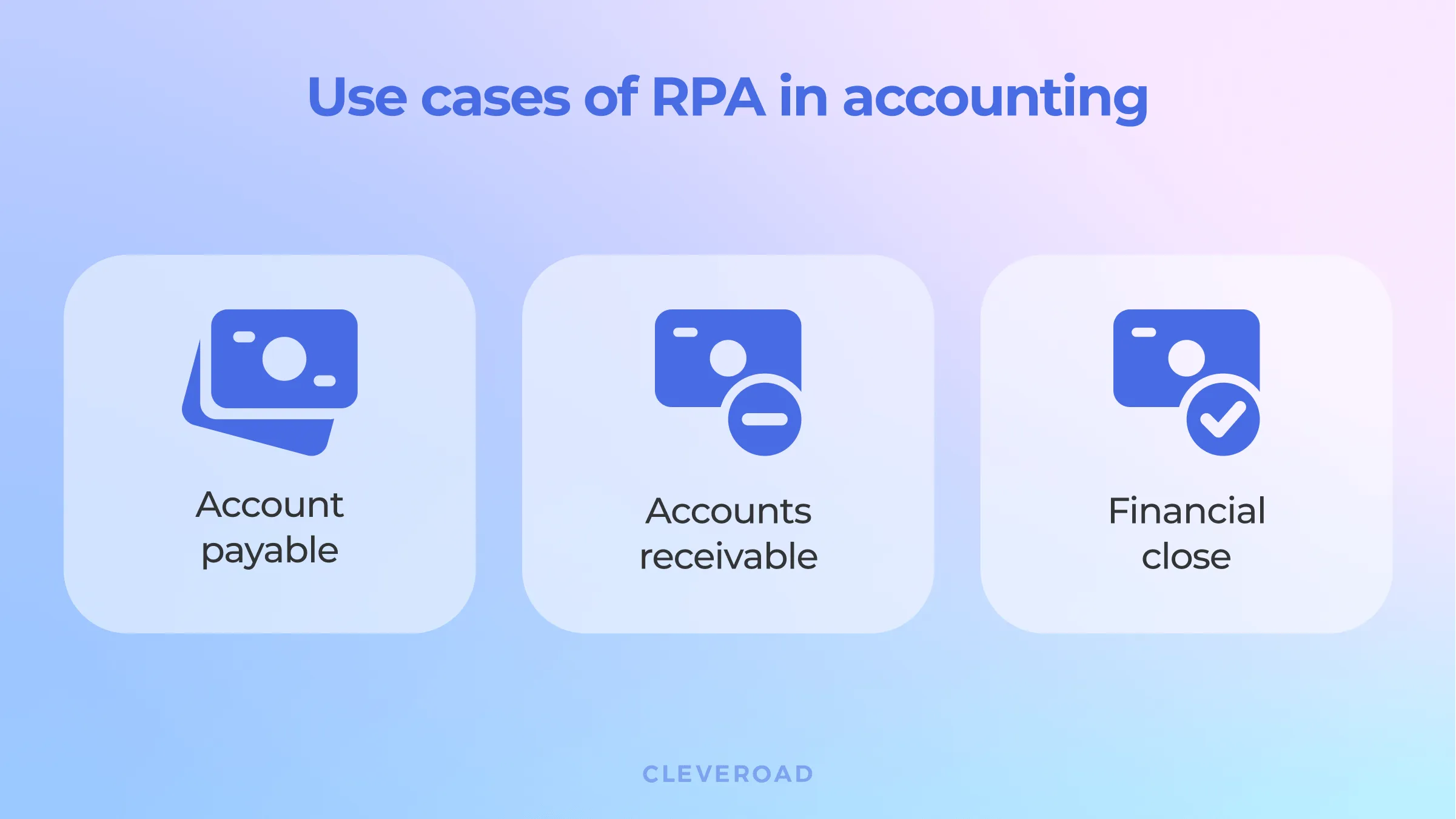
3 examples of finance RPA in accounting
Preventing Money Laundering
Today, each bank has a department to deal with money laundering. Their task is to monitor the transactions on high-risk accounts and detect suspicious activity. Investigators have to manually check every domestic and international transaction made with this account. It’s a time-consuming process because employees retrieve checks on transactions manually from a database.
What are the benefits of RPA in finance and accounting? Robotic software simplifies the process of retrieving checks. When the software notices suspicious activity, it automatically downloads checks for a predefined period of time. This results in an increased number of solved fraud cases and increases the productivity of investigators. Moreover, this system works round the clock so that auditors can work on new cases right from the start of a new working day.
With the help of AI, RPA software could solve even more problems, like comparing transactions and identifying suspicious payments. However, AI-powered RPA software development can cost you a fortune, so it’s crucial to calculate expenses wisely.
For example, Standard Bank, the largest bank in Africa, after implementing WorkFusion RPA, reduced the verification time to 60%, and this solution helped automate up to 1 million transactions per month.
Trying to figure out the difference between AI, data science, and machine learning? We got you covered!
Quick Bank Account Opening
The bank account opening process requires a manual data entry or even a client’s physical presence at the bank branch. If clients make a mistake during data entry, the client support specialists have to reach back to them to clear things up. This action takes time from your employees and slows down the overall process of registration. RPA for finance and accounting offers an alternative that can eliminate the chances of a mistake.
To open a bank account, clients have to upload a photo of their driver’s license or ID. Then, finance automation RPA software digitizes the documents provided with the client and matches the ID with the government registry's information. If there’s any information missing (like a date of birth) the bank’s employee has to solve this issue with a client. Finally, the verified data is transferred to the bank system, and clients receive their banking details. A well-built ID transcribing system grants the data accuracy, so client support employees will have less work to be done.
Danske bank is a great example of how to automate the customer onboarding procedure. The bank has developed a robot that transfers the data collected during an onboarding meeting by a bank adviser from the client. The adviser has to enter data into the onboarding platform and then into the customer portal platform. Initially, it took around 20-30 minutes during each meeting. With the help of the RPA solution this time was reduced to mere seconds.
Updating Customer Data
Banks keep a lot of information about their clients, and this information should always stay relevant. Unstable data, like the phone number or a client’s address, require a recurrent verification. Obviously, you can’t call your customers once a month to ask about their current address. However, robotic process automation in finance has some other useful options.
RPA in finance and accounting can make queries to a government registry database to update the data on its own. Updating the client’s information is an essential procedure, especially when you’re dealing with loan processing. The government registry keeps all the information you have to know about the client. The only issue is to find the client’s phone number. Today, SIM cards are easy to purchase, and in some countries, cellular providers don’t even ask for the ID during the mobile number registration. You can still develop RPA software that can extract the information from your clients’ social media. Users often display their numbers on their social pages.
Accordingly, this use case lets you stay informed about the changes in your clients’ personal data without disturbing them personally.
In addition to updating the data, banks also constantly check the authenticity of the data provided during the issuance of loans and other foreign exchange transactions. This process is called KYC and can also be automated. Instead of the consultant manually checking the data against various databases, an automated algorithm can do it in a matter of seconds. This advantage has been taken by Axis Bank, which is India's third-largest private sector bank. Automating the KYC process has helped reduce errors by up to 70% while reducing labor costs by 30%.
Detailed Information About Bank Services
Banks provide many services. Each of them has some pitfalls and unclear details. If we’re talking about the lending process, banks should take into account the client’s credit history, income level, the number of transactions made, and more. Credit and deposit calculators are another robotic process automation finance use cases that shed light on the lending process for customers.
A plain calculator simply displays the overall payment based on the maximal credit term, an initial payment, and product price. However, clients don't know the chances of getting a loan using this calculator. RPA based calculators can analyze the client’s capacity to pay and output the real periodic payment and a preliminary bank’s decision.
The same thing with deposit calculators. An RPA-based calculator can calculate the bonuses for regular customers, deposit fees, and produce the final interest rate for the deposit. This is one of the most popular RPA use cases in finance that brings transparency to loan and depositing systems and inspires trust among your potential clients.
We can take a look at Bancolombo’s use case of RPA for investors. The largest bank in Colombia, uses RPA finance solutions to provide their clients with market insights, analysis of their portfolio performance, and make suggestions on further investments. This feature is available to any client with an investments portfolio of more than $7,000.
RPA Preparation Steps for Businesses
Understanding of use cases isn’t enough to implement Robotic Process Automation in finance. To create an efficient and cost-effective system, you have to come up with a plan and stick to it. In this section, we’ll have a closer look at four main preparation steps before the development of robotic process automation in finance.
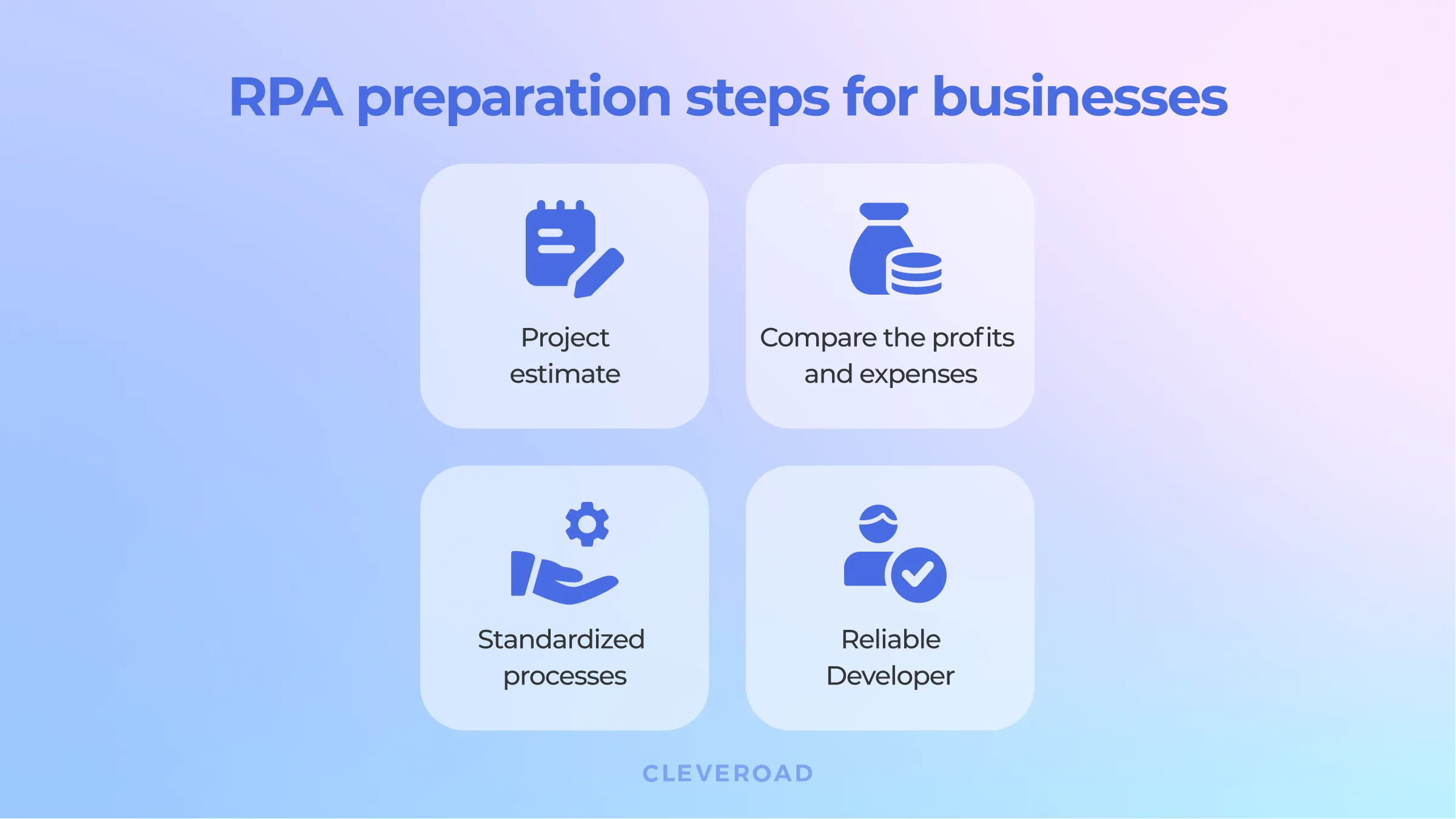
4 steps to take before automating financial processes
Project Estimate
The estimate is an initial stage of any project. At first, you have to choose a process that you’re going to automate. Usually, that should be an operation that involves manual transferring of large amounts of data. A successful automation of such processes leads to a faster return on your investments (ROI).
Then, you have to build a feature list and describe an idea of how this RPA finance software is going to work. Don’t overload your software with useless features. Each hour of developers' work costs you money, so treat the feature list with all the responsibility. After the feature list is made, contact a software development companyto estimate your project.
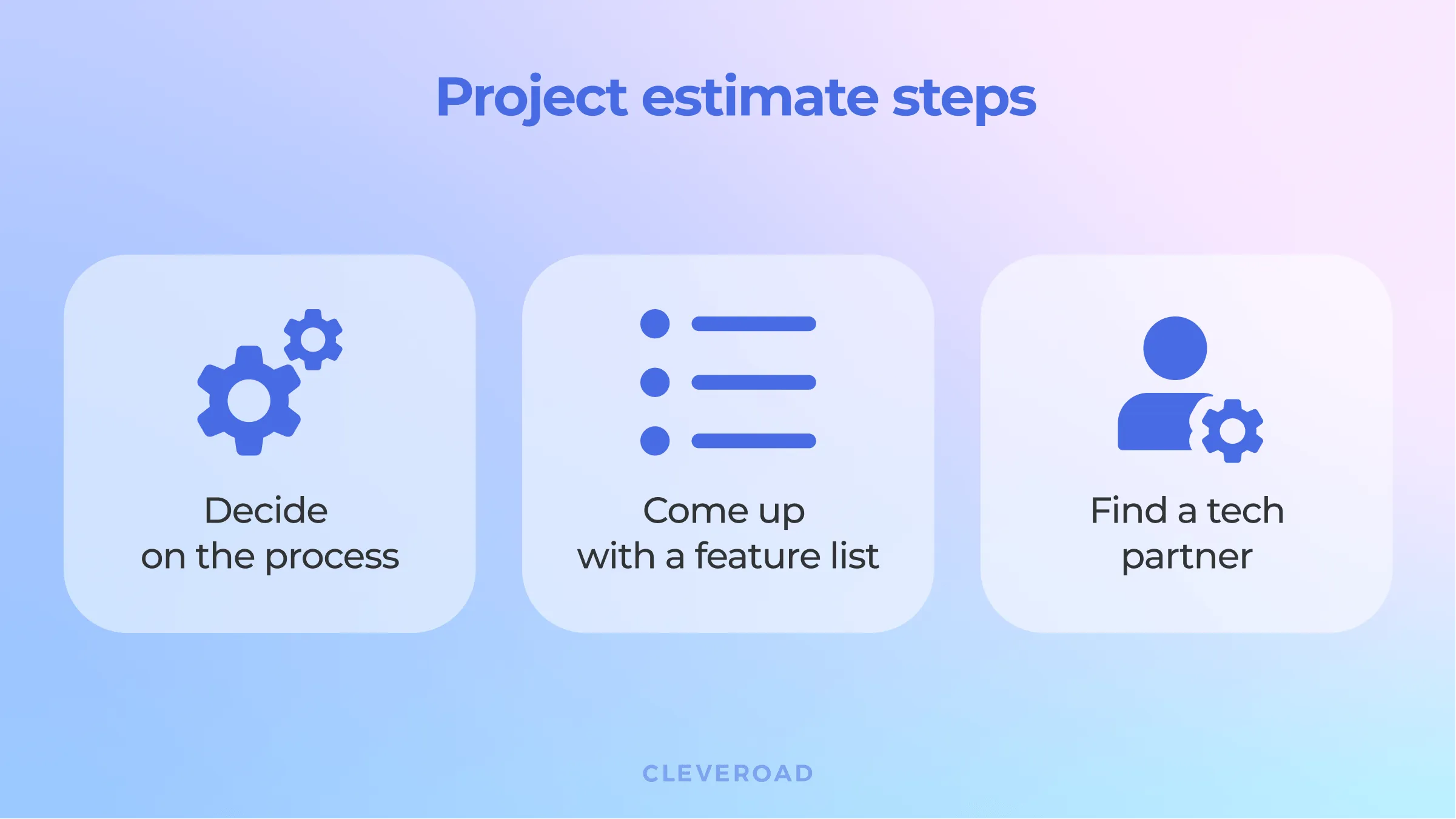
Steps to estimate your software project
Compare the Expenses and Possible Profits
When you know the cost of software development, it’s time to compare it with the possible earnings. Calculate how much working hours per month this software can reduce and how long it’d take to pay off.
Take a look at a client support automation use case, for example. Let’s assume that your software can reduce the workload of your employees for 20 hours/month. With an average salary of a customer support officer of $18/hour, the software saves you $360/month per each employee.
However, if the development process costs you $100,000, and you have only two client support employees, it will take almost twelve years to pay off. That’s an unacceptable return of investment term. Therefore, you have to weigh a possible profit and make a decision carefully.
Standardize Related Processes
RPA in finance and accounting can work only with standardized processes. Like any other computer program, this one needs a strict sequence of actions that should be performed one by one. Before the integration, your employees have to build a clear and straightforward system for the task you’re going to automate. Whether it’s a bank account opening or credit issuing, make the process follow a routine and rule-based order with only one expected result.
Hire a Reliable Vendor
The last step of your preparation is to find a reliable software development team. If you own a large company, you probably have an IT department to come up with technical requirements and organize the development process. However, if you're in charge of a small company, you still have options for developing RPA for finance and accounting.
Instead of a costly in-house team, you can hire an outsourced software development company. They usually deliver the same product quality for a lower price. Outsourcing companies have experienced development teams and meet all the deadlines. By the way, Clutch rates vendors based on clients’ reviews. You can use it to find a company that meets your needs.
Need a professional capable of implementing RPA in finance? Check our full guide dedicated to RPA developers roles and responsibilities
Implementation Steps
After you find an experienced and reliable vendor, it's time to start developing and implementing an RPA solution in your financial business. The whole process consists of sequential steps that you should know about.
Step #1. Analysis
At this stage, the vendor thoroughly examines your requirements for the future RPA system. In addition, the vendor studies the structure of your business, its business processes in order to understand the automation options and what tools are needed for this. All information is documented in a detailed specification that combines all requirements and technology descriptions.
Step #2. Development Estimate
Based on the data obtained, vendor's analysts calculate the time on developing RPA solutions for your needs. Once the exact time is known, it is converted into the final development cost.
Step #3. Development Process
At this stage, the development of RPA for finance and accounting begins based on your requirements and desires. All development is divided into sprints, which usually take two weeks. During each sprint, developers create a certain part of the functionality and present it to you. This process is repeated over and over until all functionality is created and all integrations are added.
Step #4. Quality Assurance
RPA at the output must work flawlessly, so Quality Assurance engineers are involved in the development process to achieve such polishness level. They conduct deep testing of the created functionality, identifying malfunctions, bugs, and other flaws that developers could have missed. Further, all errors are packed into bug reports sent to the developers, and on this information, the developers polish the roughness to roll out the bug-free product.
Step #5. Implementation
After all the sprints are completed, the final stage begins, namely, the polishing and implementation of RPA into your business processes. The developers put the final touches on the RPA functionality, cooperate with your technical specialists to implement automation, and also, upon request, carry out the onboarding of personnel on the new functionality. After that, you can continue cooperation with the vendor to further system support or end cooperation.
Cleveroad Experience
Here, at Cleveroad, we have a lot of financial processes going on around. And as a software development company, we’re eager to automate as many operations as we can. So, take a look at some of our RPA use cases in finance for generating financial documents and optimizing financial CRM.
In the first case, we’ve developed software for Invoicing and Acceptance/Delivery Certificate. Our accountants load .xls file to the platform. This file contains a list of employees and their personal data. The service processes the data and automatically generates two .pdf files — Invoices and Acceptance/Delivery Certificates for all employees. The service has a web version. Out .Net team used the following technologies to make it work:
- .Net Core 3.1
- TypeScript
- SaSS
- AWS EC2
- AWS RDS
As for financial CRM, it was taking too much time to load tables and hop between data-filled pages. That’s why we’ve built a database solution that’s capable of storing over 1 million records and fast-loading them during page-to-page views. You can test it here. As we couldn't find any appropriate framework for this task, we had to build it from scratch. We’ve used the following technologies to make it work:
- MySQL
- .Net Core 3.1 for the back end
- Angular for front end
- AWS EC2
- AWS RDS
As you can see, the creation of RPA for finance and accounting requires professionalism from the vendor that you should choose for your project. In addition, you must approach the automation process as responsibly as possible. You must consider all the nuances of your business, analyze internal processes and compare expenses to the potential profit from automation. With this approach, the chosen ready-made solution or the custom-developed one will bear fruit and be profitable in the long term.
Ready to build your RPA project?
We can help you choose the process for automation based on technical details. Consultation is free.
Robotic process automation in finance is software that automates routine tasks and reduces the employees' workload. Usually, it’s applied to already existing, well-established financial processes. Automation includes data processing and communication between systems.
RPA in finance can manage transactions, display bank account info, and provide interest rates for customers. Besides, RPA is very beneficial for accounting. This software can produce invoices, perform gross-to-net processing, and more.
The best RPA use cases in finance are:
- Accounting
- Preventing money laundering
- Quick bank account opening
- Updating customer data
- Providing detailed information for investors
To automate processes with finance RPA, you have to take care of four main points:
- Project estimate
- Comparison of expenses and possible profits
- Standardizing related processes
- Hiring a reliable vendor
Here are the most evident benefits of RPA in finance:
- Robots can’t forget anything.
- Unlike people, robots can work 24/7.
- Robots manage low-level tasks, like typing or transcribing texts way faster than people.
- Robots can’t be distracted. Staff members are frequently distracted by phone calls, chats, and other tasks. But RPA in the finance sector is all about single-tasking, so robots can’t do anything else while they have an unfinished task.
The future of RPA in the financial sector is very promising. For now, there's a number of processes that can be automated. RPA can bring benefits to employees, business owners, and clients. Thus, this field will strive and prosper.

Evgeniy Altynpara is a CTO and member of the Forbes Councils’ community of tech professionals. He is an expert in software development and technological entrepreneurship and has 10+years of experience in digital transformation consulting in Healthcare, FinTech, Supply Chain and Logistics
Give us your impressions about this article
Give us your impressions about this article
Comments
2 commentsgreat post

Thanks, Vilhelm! Stay with us for even more informative content!
Hey, this is a brilliant post and the right one at the right time. Yes, RPA is essential right now to streamline core processes and workflows, to build agility and flexibility for all industries around the world for success during the pandemic or to recover in a post-pandemic world. Regards, Raj, Nous

Thanks for your opinion! We also believe that RPA can change any industry for the better.